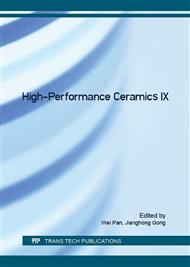p.173
p.178
p.182
p.188
p.193
p.198
p.203
p.207
p.211
The Influence of Al2O3 and TiO2 Additions on the Sintering Behavior of Partial Reaction Bonding Silicon Nitride
Abstract:
To compare the influence of Al2O3 and TiO2 on the sintering behavior of partial reaction bonding silicon nitride (RBSN) and post densification behavior, different amounts of Al2O3 or TiO2 have been added into Si-Si3N4-Y2O3 system. The results indicated that a high amount of Al2O3 addition inhibited the reaction bonding process, a lower nitridation degree was obtained, while TiO2 has limited influence on nitridation, only slightly decreased nitration degree with increasing TiO2 addition. After post sintered at 1800 °C, a density ranging from 2.31 to 3.09g/cm3 were obtained with additions of Al2O3 and TiO2, much larger than the one without them. The linear shrinkage of post-sintered samples was strongly promoted with high Al2O3 content, but it was irrelevant with the amount of TiO2. The highest bending strength of 523MPa can be obtained with addition of 6wt% Al2O3. TiO2 transformed into TiN which located at grain boundary interfaces, restraining the grain growth of β-Si3N4 and leading to an inferior flexural strength after post sintered at 1800 °C.
Info:
Periodical:
Pages:
193-197
Citation:
Online since:
July 2016
Authors:
Keywords:
Price:
Сopyright:
© 2016 Trans Tech Publications Ltd. All Rights Reserved
Share:
Citation:


